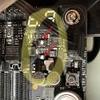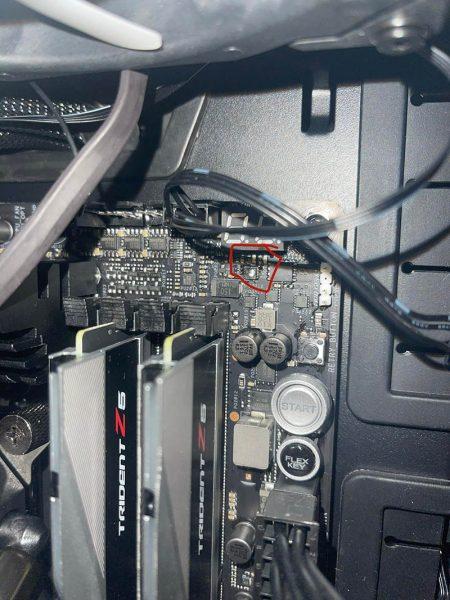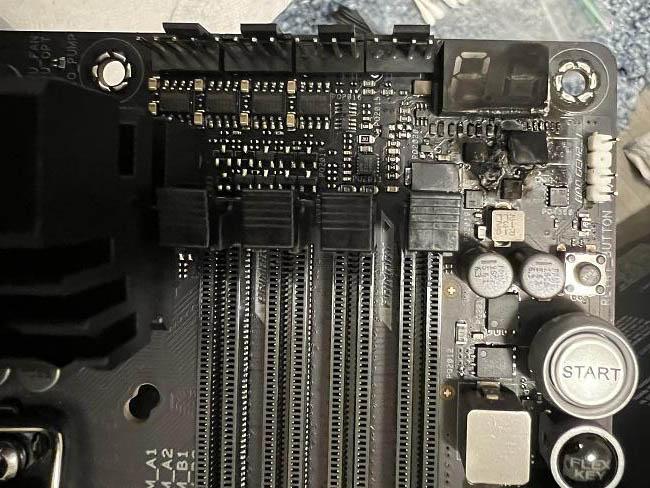Numerous users have reported issues with their ROG Maximus Z690 Hero motherboards via the Asus forums, Reddit, and a variety of other sites, all of which are related to an integrated circuit powering the RAM memory burning and, in some cases, catching fire for a few seconds.
Following this, the system fails to recognize the RAM, resulting in an orange light during the startup process and the code 53 on the DEBUG screen, both of which indicate RAM difficulties.
The following are some testimonials, as well as photographs of the motherboards following the incidents:
u / Rockman 4 on Reddit
Another Z690 Maximus Hero with Q-Code 53 that I received from a Newegg combo with G.Skill 6000CL40 memories (F5-6000U4040E16GX2-TZ5RS). I was running stress tests with no problems. After that while just browsing the web I heard a loud pop and the system immediately froze, the motherboard was glowing in the upper right corner, and I smelled burned electronics. Mine shows PCB damage, however not as extreme as the ones seen on the Asus forum.u / TheMaxXHD on Reddit
Hi all,As the title mentions, it appears that there is potentially a problem with the Z690 Hero motherboards. I have built a new computer myself using the new Hero board. Purchased direct from Newegg with a combo including DDR5 due to a lack of DDR5 at the moment. I bought all the components and assembled the system. I turn it on, install windows, and everything is fine. Around five o'clock, while I was just browsing the internet, it suddenly turns off, as if the power had been cut. I try to turn it on again, but nothing. I smell a burning smell coming from the motherboard.
To see what failed, I went to Microcenter and bought three items, another 12700K (in case the first one died with the motherboard), another Z690 Hero, and another corsair RM1000x (in case it was the power source). I saw that the power supply was not dead, and the motherboard was. So I replaced the motherboard (Luckily no other components were taken including my GTX 1080). I reset everything to zero again, making sure there are no wires misplaced or installed where they shouldn't. I turn on, it works, and I configure everything to keep it running. As a sanity test, I run AIDA64 on the CPU and ram, and Furmark on the GPU, both for two hours, to make sure nothing is really wrong. All good, no problems. I play a bit of Battlefield 2042 later, there were no problems there either. Later, Later in the evening while I'm surfing the internet it shuts down again, and this time when I look at the motherboard I see a component literally on fire. I quickly turn off the fountain and unplug it from the wall (The motherboard was also tried to reboot during this process before I turn off the fountain and pluck the cord from the fountain connector to ensure that it won't set my house on fire).
At this point I start to get suspicious. A bad lemon, good. Two, with exactly the same flaw, it's no coincidence. […] So I go to this reddit to see if maybe, just maybe someone else said something. To my surprise, I find that more people struggled with the exact same component.
Along with these users, there are other testimonies, such as u / Syke408 , u / Duhjano, where additional impacted individuals comment, and the list continues in other places, such as this one on the Asus forum.
Some users report that they updated to the latest BIOS as soon as they assembled their PC and have not encountered any issues of this nature, although others report that they experienced hardware failures similar to those described previously even with this BIOS, so it is not yet clear what the issue is. There is a greater emphasis on the problem than on how to resolve it. Asus representatives who responded to the numerous posts have thus far confined themselves to proposing motherboard replacements.
Update: It is almost certain that the problems are caused by a misplaced capacitor: a comparison with a working unit if you look at the capacitor placement it shows that the lettering on the closest capacitor is reversed, whereas it is upside down on the defective ones. The marking on the component indicates that the polarity is reversed, which is obviously damaging to the motherboard's operation.
Unless there have been multiple revisions of the Hero motherboard it is likely an error during the production process. While such components are typically attached mechanically, an employee may have topped off the capacitors in question erroneously. We checked on our sample and compared in the image shown above, our sample is placed correctly. So likely a small batch is affected.
Asus thus far did not comment on this finding.
Consumers are reporting that their ROG Maximus Z690 Hero is malfunctioning (updated)





